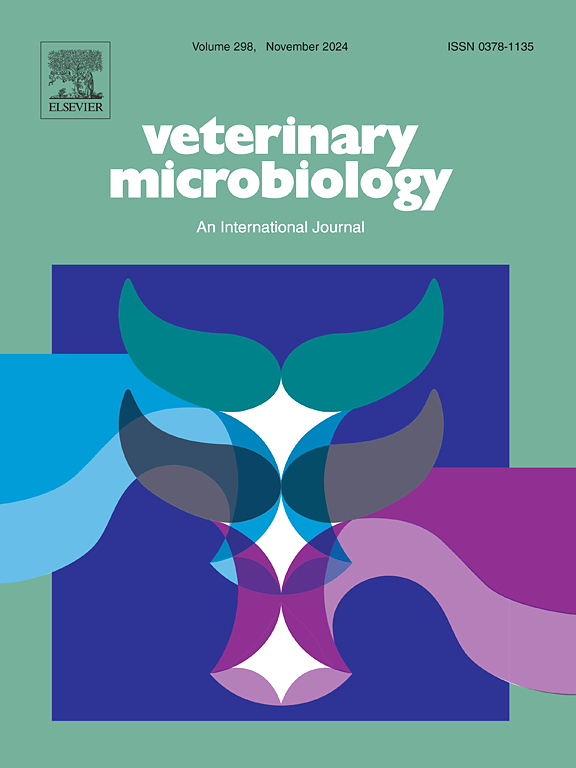Foot-and-mouth disease virus 3C protein acts as an anti-inflammatory factor by mediating degradation of TLR4 signaling various molecules via caspase activity
IF 2.4
2区 农林科学
Q3 MICROBIOLOGY
引用次数: 0
Abstract
During the early stages of foot-and-mouth disease virus (FMDV) infection, a series of acute inflammatory responses occur in the host. As the disease progresses, these inflammatory responses gradually weaken until the host is nearly recovered. However, the mechanism by which FMDV participates in the negative regulation of host inflammatory responses remains unclear. In this study, we found that FMDV 3C plays a crucial role in inhibiting the inflammatory response by degrading various molecules in the TLR4 signaling pathway. Mechanistically, we discovered that this degradation is mediated by caspase activity, which is activated by 3C protease. Specifically, FMDV 3C targets TLR4, TRIF, p65, IRF3, and TBK1 for degradation through caspase-3, and degrades IRF3 and TBK1 via caspase-8. Notably, FMDV 3C targets TBK1 for degradation through caspase-3, caspase-8, and caspase-9 independently. In conclusion, this is the first report identifying FMDV 3C as an anti-inflammatory factor that mediates the degradation of various molecules to inhibit TLR4 signaling through caspase activity. This study provides a novel insight into explore the relationship between FMDV and inflammation and offers ideas for exploring the biological function of 3C and the pathogenesis of FMDV.
口蹄疫病毒3C蛋白作为一种抗炎因子,通过半胱天冬酶活性介导TLR4信号的降解
在感染口蹄疫病毒(FMDV)的早期阶段,宿主体内会发生一系列急性炎症反应。随着疾病的进展,这些炎症反应逐渐减弱,直到宿主几乎康复。然而,FMDV参与宿主炎症反应负性调控的机制尚不清楚。在本研究中,我们发现FMDV 3C通过降解TLR4信号通路中的各种分子,在抑制炎症反应中起着至关重要的作用。在机制上,我们发现这种降解是由半胱天冬酶活性介导的,半胱天冬酶活性由3C蛋白酶激活。具体来说,FMDV 3C通过caspase-3靶向TLR4、TRIF、p65、IRF3和TBK1降解,并通过caspase-8降解IRF3和TBK1。值得注意的是,FMDV 3C单独通过caspase-3、caspase-8和caspase-9靶向TBK1降解。总之,这是首次报道FMDV 3C作为一种抗炎因子,通过caspase活性介导多种分子降解,抑制TLR4信号通路。本研究为探索FMDV与炎症的关系提供了新的视角,为探索3C的生物学功能和FMDV的发病机制提供了思路。
本文章由计算机程序翻译,如有差异,请以英文原文为准。
求助全文
约1分钟内获得全文
求助全文
来源期刊

Veterinary microbiology
农林科学-兽医学
CiteScore
5.90
自引率
6.10%
发文量
221
审稿时长
52 days
期刊介绍:
Veterinary Microbiology is concerned with microbial (bacterial, fungal, viral) diseases of domesticated vertebrate animals (livestock, companion animals, fur-bearing animals, game, poultry, fish) that supply food, other useful products or companionship. In addition, Microbial diseases of wild animals living in captivity, or as members of the feral fauna will also be considered if the infections are of interest because of their interrelation with humans (zoonoses) and/or domestic animals. Studies of antimicrobial resistance are also included, provided that the results represent a substantial advance in knowledge. Authors are strongly encouraged to read - prior to submission - the Editorials (''Scope or cope'' and ''Scope or cope II'') published previously in the journal. The Editors reserve the right to suggest submission to another journal for those papers which they feel would be more appropriate for consideration by that journal.
Original research papers of high quality and novelty on aspects of control, host response, molecular biology, pathogenesis, prevention, and treatment of microbial diseases of animals are published. Papers dealing primarily with immunology, epidemiology, molecular biology and antiviral or microbial agents will only be considered if they demonstrate a clear impact on a disease. Papers focusing solely on diagnostic techniques (such as another PCR protocol or ELISA) will not be published - focus should be on a microorganism and not on a particular technique. Papers only reporting microbial sequences, transcriptomics data, or proteomics data will not be considered unless the results represent a substantial advance in knowledge.
Drug trial papers will be considered if they have general application or significance. Papers on the identification of microorganisms will also be considered, but detailed taxonomic studies do not fall within the scope of the journal. Case reports will not be published, unless they have general application or contain novel aspects. Papers of geographically limited interest, which repeat what had been established elsewhere will not be considered. The readership of the journal is global.
 求助内容:
求助内容: 应助结果提醒方式:
应助结果提醒方式:


